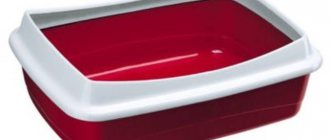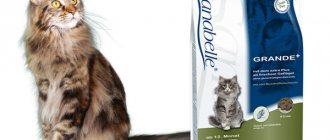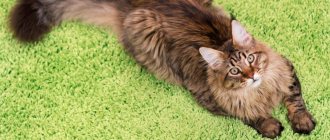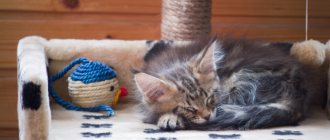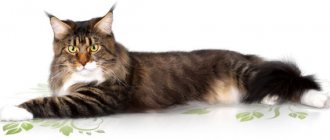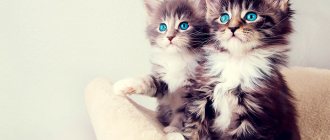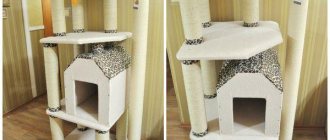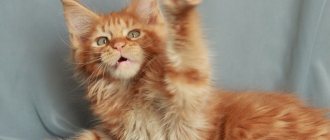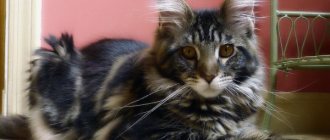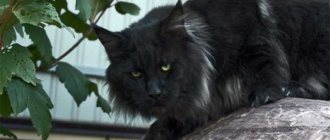Maine Coons are large, active cats with a playful character. Therefore, the “potty” for a pet of this breed must correspond to the considerable size of the animal, and its design must minimize the mess caused by the coon when visiting the toilet. The minimum dimensions of a tray for Maine Coons are 40x80 cm, the height of the sides is at least 10 cm. In addition, the tray must be stable.
For a kitten just brought home, it is recommended to purchase a tray of the same type that was in the nursery. A child experiences serious stress when moving, so it is important that objects familiar to him from his previous home appear in his new environment. Soon the tray will have to be changed anyway - the Maine Coon will grow up, and the old “potty” will be cramped for him.
What to consider when choosing a litter box for your Maine Coon
Maine Coons are big cats, which means they need an appropriate litter box. Ordinary cheap “pallets” will not suit even large cats of other breeds, not to mention these famous size winners in the cat world.
Dimensions
The first and main reason why a Maine Coon will not go to a small litter box is a simple inconvenience. Cats are very clean animals, so they will never sit down to do their business in a place that does not suit them.
IMPORTANT! The Maine Coon should fit completely in its toilet, have relative freedom of movement there and feel comfortable and clean.
A few more reasons why a Maine Coon litter box should not be small:
- There will be a lot of garbage. Let's say you have trained a kitten to use a standard litter box, but when he grows up, even with the most careful use, litter will be scattered everywhere, and sometimes puddles will spill.
- There are no small closed litter boxes for Maine Coons. A new trend among cat owners is closed litter trays, which only come in large sizes.
Material
The standard material for a quality tray is weighted plastic. This is convenient for both the cat and the owner - it is easy to wash and carry, and the filler does not stick to the surface. It is not recommended to purchase trays with decor or interspersed with soft materials.
Firstly, the toilet must be primarily functional - the cat must be able to use it at any time, and the owner must be able to quickly wash/change the litter. Secondly, unnecessary elements can not only interfere, but also get dirty.
Which toilet is better and why?
The size of the cat potty should correspond to the weight of the Maine Coon, so that the cat does not feel constrained and can freely scoop up the litter. A closed litter box with a door is suitable for this breed. The pet will be able to calmly, without distraction, go to the toilet, without scattering the litter throughout the room. An open box is also suitable for tailed pets, but it is better to give preference to large containers for Maine Coons with sides, since cats of this breed love to dig into the litter. The sides in these toilets are installed with the edges going inward to avoid clutter. Household plastic basins and Maine Coon bowls with high sides are also used as toilets.
Rectangular plastic box with small sides
A plastic tray is suitable for small cats, but it will not be convenient for an adult.
It is a plastic pot without sides and additional functions that help keep the room clean. That is why the contents scatter and spread throughout the apartment. The tray is uncomfortable for an adult cat, although it is ideal for kittens. Easy to wash and does not take up much space. Trays with a grid for draining urine, under which the filler is hidden, are in demand, while the pet does not come into contact with the contents of the toilet and does not taste it.
Open box with sides
This type of bowl is suitable for adult cats, equipped with additional sides, and looks like a box. This toilet attracts cats with its appearance and large size. The inwardly curved sides help owners avoid clutter around them by preventing the spread of filler. However, such a toilet does not eliminate the smell of the contents.
Closed tray
A tank-like box with a door. It is important that the size of the Maine Coon tray is large enough and convenient for cleaning. A closed house has special advantages over the types listed above:
- Delays the spread of unwanted odor from the box throughout the apartment.
- An animal visiting the toilet is not distracted by external factors while being inside.
- Tray houses are equipped with special carbon filters that absorb the smell of cat feces.
Filler selection
Now there is a huge selection of fillers - from standard ones, which cost not much more than regular sand, to luxury options. It is advisable to equip the toilet for such large cats as the Maine Coon with the best materials - the impressive size of such cats leads to the fact that the remains of the litter (used or still fresh) are carried on their paws throughout the apartment.
IMPORTANT! It is highly not recommended to save money and put homemade filler in the tray - newspapers, toilet paper, etc. - the cat will try to bury until the last minute, resulting in more soiling.
Types of filler:
- Standard (cheap). You can buy it not only in a specialized pet store. Usually based on sand or other common materials.
- Luxury. You can buy it in pet supply stores or large supermarkets, or online. It has the property of not clumping, absorbing odor, not sticking to paws and absorbing moisture.
Everyday care
The rules for daily care of Maine Coons are not particularly original. Day after day you will need to do the following:
- monitor the condition of the eyes and ears, if necessary, clean them (ears - with a special lotion and a cotton pad, eyes - with a swab dipped in weak tea leaves);
- check whether the oral cavity is clean and whether plaque has appeared; if necessary, treat the teeth with a special paste for cats using a very soft brush (kittens need this procedure daily during the period of changing teeth);
- comb the coat thoroughly (at least once a week), remove tangles if they appear;
- make sure that the claws are not too long, trim if necessary (only with a special “guillotine” and very carefully so as not to touch a blood vessel; if you are not confident in yourself, it is better to consult a specialist for trimming the claws! ).
The last point will not cause much trouble if you have made sure that there is a convenient scratching post for the Maine Coon in the house. If it is, your pet's claws will not grow too long, causing him inconvenience and even pain.
How to train a Maine Coon kitten to use the litter box?
The main work on training a cat to use the litter box should be done while the kitten is still very small. If the baby has a mother, then most likely there will be no need to intervene - the cat will teach him herself, but in the case when a kitten is adopted from a breeder, responsibility for the future hygiene of the cat falls entirely on the owner.
IMPORTANT! It will take a long time to accustom your baby to the litter box (perhaps a month or even more), but you should not take the problem lightly - retraining an adult cat or even a teenager will be very difficult.
How to teach a kitten to go to the toilet in the right place:
- Planting in a tray. The kitten itself will not think of going into the litter box, even a low one. At first, you will have to put it there as soon as the cat is about to defecate - this can be easily determined by its specific position.
- Determining the time for the toilet. Few cat owners know that an animal’s “toilet schedule” can be regulated and even slightly controlled through a steady supply of water before bed and a normal diet.
- Praise in a timely manner. Potty training your kitten isn't just about getting him to the right litter box, it's also about positively reinforcing the new habit. Praise the baby clearly and with a positive intonation, pet him, even if he didn’t actually do anything, but was simply brought into the tray by you.
What you definitely shouldn’t do is scold the kitten, much less hit it. This way you will not at all speed up the process of adaptation to new conditions, but only slow it down. The kitten does not understand for what specific reason you need him to go to the toilet in a certain place, so you can only persuade him through positive reinforcement.
IMPORTANT! To help himself, the owner can use special means that attract cats to the correct toilet and scare them away from the wrong one. Such remedies help with varying degrees of success, it all depends on the cat.
Kinds
Nowadays, you can easily choose a tray for a cat, since their range is very diverse in terms of design and color, so it’s not difficult to choose a tray that matches the color of the interior of the room where it will be placed. But in order to choose the right litter box for your Maine Coon, you need to know the advantages and disadvantages of each type of litter box.
Since adult cats of this breed are large in size, they need a fairly large tray, the minimum dimensions of which should be 40x80 cm.
Rectangular with low sides
Almost all other cats can use this litter box successfully.
But it is completely unsuitable for adult Maine Coons.
After all, these cats love to dig up litter.
Because of this, the granules will scatter far from such a tray every time your pet visits it.
For a small kitten of this breed who is just beginning to learn the “wisdom of the toilet,” such a tray will be very good. Kids are not afraid of its appearance, and the low sides allow the kitten to use it independently.
With high sides
Trays of this design often have additional sides that increase their height even more. For Maine Coons, such a tray is quite acceptable, since the high sides prevent the litter from scattering even if the pet vigorously rake it. In addition, cats like litter boxes with high sides as they create the illusion of an enclosed space and make them feel confident and safe.
For Maine Coons, trays with sides and a height of at least 10 cm are suitable.
Closed house
It is a closed structure that resembles a carrier in appearance and is equipped with a hinged door on the side.
One of the advantages of this design is that there is almost no unpleasant odor in the house from such a cat litter box.
After all, trays and houses are often equipped with carbon filters that absorb animal odors. Cats, as a rule, willingly use such trays, since in the toilet-house nothing distracts them from the process.
The disadvantages of closed toilets include their high price compared to other trays and the fact that they are inconvenient to clean if the tray does not slide out or if the top part cannot be removed from them. Therefore, if you decide to buy a closed type tray, in the form of a house, then you need to choose the model that has a removable top or the one that is equipped with a retractable tray.
This is interesting: Photo of a white Maine Coon
And again about wool
We have already found out that it is necessary to care for the Maine Coon’s fur especially carefully and meticulously. What exactly is included in the concept of care?
First of all – combing, combing and combing again. It is necessary to bathe periodically, but you should not overuse water procedures - this can have a bad effect not only on the delicate skin of the maine, but also on its delicate psyche. In addition, the domestic cat does an excellent job of maintaining cleanliness.
Tools
For proper combing you will need a whole arsenal:
- wide-toothed comb for initial combing;
- a fine-toothed comb for adding shine;
- a comb with very fine teeth – to remove dirt (do not use on the collar, tail and pants, where hair grows slowest);
- slicker brush - for the molting period (if your cat accepts this device without protest);
- massage brush – to remove residual fallen hairs;
- nail scissors - to cut out (if necessary) the resulting tangles if they could not be sorted out and combed.
All instruments must be of high quality, with rounded ends of the teeth to prevent microtrauma. You should make sure in advance that your pet is not afraid of these tools. Since keeping a Maine Coon requires constant “hairdressing” procedures, it is necessary to accustom him to a comb from childhood.
What to do with tangles?
You should be especially careful with tangles; carelessness here can lead to the wool turning into felt. It’s better not to let them get to you at all; for this purpose, regularly inspect those places where matted areas are most likely to appear, that is, the cat’s stomach, neck, chest and hind legs. After this, you can start actually combing. The order is as follows: first we process the tail (extremely carefully!), then the back and sides, and finally the chest, stomach and panties. We move smoothly, without jerking, in the direction of hair growth. Everything is quite simple, although it requires some skills. The main thing here is not to hurt your pet.
What is a scratching post for?
Sharpening claws is not a game, not a prank, but a physiological need of all cats, both wild and domestic. Using this procedure, the cat puts its main weapon - its claws - into combat readiness, makes them sharp and clears them of dead tissue. In addition, the animal stretches out, stretching its back, and also marks its territory - between the toes of cats there are glands that distribute their personal scent, and the height of the scratches indicates the status of the animal.
But, if a cat living in natural conditions can sharpen its claws on a tree trunk, then an indoor pet is often forced to be content with carpets, wallpaper and furniture, which causes mixed emotions among owners. To prevent such troubles from happening, you need to purchase or make a scratching post yourself.
Other useful accessories
A simple design will contain only two elements - a Maine Coon house and a scratching post. If desired, this modest set can be supplemented with new items.
- Add another round or rectangular stand braided with cord.
- Shelves are made between two claw masts.
- Cats are very fond of hammocks, which are stretched over the supports of the structure.
- They arrange transition ladders or connecting slats that resemble a narrow cornice.
All additional attributes must be covered with fabric, and when using a pipe or timber, they must be wrapped in rope braiding.
Where to put?
Its location plays an important role in toilet training a furry pet. Since the tray for Maine Coons is quite large, it is not always possible to place it in the restroom. An alternative location will be the corridor. The tray can also be placed on a glassed-in loggia. But in this case, the pet must have constant access to it. In addition, the cat litter should not be located in the aisle or where there are drafts.
It is important that your pet feels safe and comfortable in the litter box. He must get to the toilet without obstacles from any corner of the home.
It is necessary to clean your cat's litter box regularly. For these purposes, you can purchase a special safe disinfectant, which is sold at any pet store. The fact is that a dirty litter box can cause rejection in a Maine Coon, since raccoon cats have a very sensitive sense of smell. Sometimes owners give their pets two trays - for “big” and “small” matters.
For the intricacies of choosing a tray and filler for a Maine Coon, watch the video below.
To cut or not to cut – that is the question
How to care for your pet is generally clear. It remains to say a few words about such an aspect as cutting a Maine Coon - is it necessary to cut it and to what extent is this generally permissible?
According to many experts, the fashion for Maine hairstyles to look like a lion, borrowed by groomers from poodles, cannot be called reasonable. Because of it, both the health and psyche of cats suffer, for which there are several reasons:
- the unique structure of the Maine’s coat is irreversibly deteriorated, including guard hair, which is not restored after shearing;
- Contrary to popular belief, a cat without fur is more, not less, susceptible to overheating;
- due to the cutting of sensitive hairs, which, together with the vibrissae, are responsible for the animal’s sense of touch, the cat’s orientation in space is disturbed, which he cannot get used to for a very long time;
- finally, the cat, whose main decoration was taken away, feels (don’t be surprised!) dishonored.
After such a shame, your handsome Maine may not recover at all and will forever lose his cheerful and lively disposition.
Finally, a shorn coon, let's be honest, immediately loses more than half of its natural beauty. The charm of the Maines lies precisely in their slightly barbaric shaggyness and hairiness (which, however, must certainly be combined with well-groomed and glossy hair), reminiscent of their free forest ancestors.
Subtleties of education
To minimize the risk of your Maine Coon wandering off anywhere, limit his movements during the first month, leaving access to the litter box, kitchen, hallway, bathroom and one room.
Allowed Methods
At the first sign of anxiety (the cat is spinning and meowing), move it to the tray and place it on the bottom. Lightly rake the litter as cats do.
As soon as the Maine Coon goes into the tray, praise and pet him, reinforcing the skill. If your pet does not have time to reach the tray, blot the puddle with a napkin and put it in the tray: its smell will orient the cat next time.
Prohibited tricks
Making your cat nervous will only delay the process of litter box training. In the arsenal of erroneous methods:
- screaming, irritation, swearing;
- physical punishment;
- repositioning the tray;
- fillers with sultry aromas.
Special advice to those who like to “poke the cat with its muzzle”: this trick will not work with a Maine Coon (it is not known who will poke whom).
